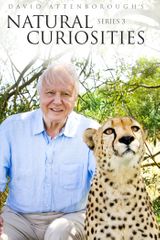
David Attenborough's Natural Curiosities 3
2015-02-02 | Documentary | 6 episodes4 Seasons
Episode
Impossible Feats (2015)
Fleas are supposed to be able to jump the equivalent of a human leaping over St. Paul’s Cathedral and cheetahs purportedly can clock speeds of 70 miles per hour. But are these claims really true? The discovery of the world's most elastic natural protein in insects and the development of a hi-tech tracking collar have helped reveal the truth. So can these creatures really achieve what should be physically impossible?

Curious Minds (2015)
Orangutans can use tools but such skills remained undiscovered for centuries. They were considered as just clever mimics until discovery in remote Sumatran swamps revealed their true potential. Clever crows also make surprisingly sophisticated tools. How have the curious minds of these two animals helped them become so inventive?

Expandable Bodies (2015)
The bodies of some animals stretch and shrink in extraordinary ways. The anaconda can swallow prey twice its own body size - and then wait for over a year until their next meal. The camel’s curious hump can almost double in weight giving it the energy to travel huge distances across deserts. What is the secret behind these expandable bodies?

Curious Feeders (2015)
The blue whale and the flamingo both have bodies determined by their diet. Blue whales grow enormous by feeding on tiny shrimp-like creatures, while flamingos spend their lives eating with their heads upside down. Both are oddities in their own groups and yet both are curiously similar.

Curious Cures (2015)
Humans are not alone in using medicines against injuries and infection. Some animals protect themselves with natural remedies in the most extraordinary ways. Hippos produce a blood-red “sweat” that acts as a sunblock and helps fight infections, while capuchin monkeys rub themselves with insect-repellent leaves to protect against insect bites.

Cast
View Live Cast Profile
Photo


